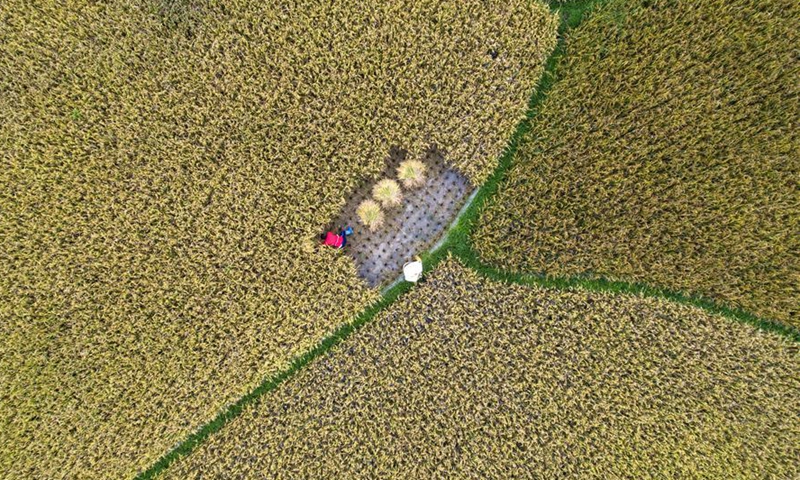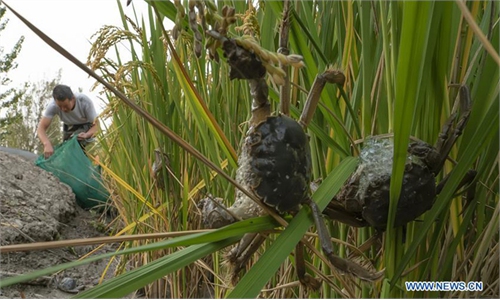
Aerial photo taken on Sept. 24, 2020 shows villagers harvesting rice in a paddy field at Jiefang Village of Hongshui Township, Qianxi County, southwest China's Guizhou Province. People are busy harvesting rice and fish in paddy fields of the village. The green and sustainable agriculture mode, which combines culture of rice and fish, has helped significantly increase yields of local farms and income of rural residents.Photo:Xinhua
China has made significant progress in rural development and completed key agricultural targets set by the 13th Five-Year Plan, setting a solid example for poverty alleviation and building a moderately well-off society in an all-round way.
During the 13th Five-Year Plan period, from 2016 to 2020, China made great strides in improving food security in both quantity and quality, said Liu Huanxin, vice Minister of Agriculture and Rural Affairs on Tuesday.
The supply of grain and important non-staple foods reached unprecedented levels, with grain output exceeding 650 billion kilos for six consecutive years, 100 percent self-sufficiency in rice and wheat, and 95 percent self-sufficiency in corn.
In 2019, China produced 77.59 million tons of meat, 33.09 million tons of eggs, 32.01 million tons of milk, 274 million tons of fruit, 721 million tons of vegetables, and 64.8 million tons of aquatic products. It is expected that the overall output of these products will maintain a steady growth in 2020 despite COVID-19.
In terms of quality, an increased number of green and premium agricultural products have found their way onto Chinese tables, with the rate of agricultural products passing quality standard tests now exceeding 97 percent, Liu noted.
Decisive action has been taken to revive China's rural areas with the promotion of modern agriculture in the east, and targeted poverty alleviation in poverty-stricken areas in the central and western regions, Liu added.
The living standards of rural residents have continued to improve, with the per capita disposable income exceeding 16,000 yuan ($2,384) in 2019, doubling that of 2010, as the gap between urban and rural areas narrows.
Thus far, industrial poverty alleviation policies have managed to cover 98 percent of poverty-stricken households, with more than 1 million industrial poverty alleviation projects and more than 300,000 industrial poverty alleviation bases being built.
It is expected that all 832 impoverished county-level regions will be lifted from poverty by the end of the year thanks to strong policy support.
The future agricultural development during the 14th Five-Year Plan from 2021 to 2025 will focus on high-quality farmland, storage and cold chain logistics facilities, digital agriculture, and animal and plant disease prevention as the country steps up efforts to further support its modern agricultural industry.
Global Times

